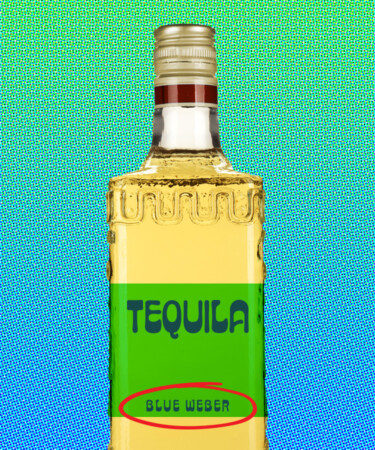Agave spirits production accelerated rapidly in the late 1800s and early 20th century, but the industry faced a major challenge: meeting growing demand. “Even after 15 to 30 years of growth in drier climates, most of the agave varieties harvested for distilled spirits hardly had enough convertible carbohydrates to produce as much alcohol as you could get by raising a small patch of cane for its sugars,” wrote Gary Paul Nabhan and David Suro-Piñera in the 2023 book “Agave Spirits: The Past, Present , and Future of Mezcals.” “That is, with the exception of just one peculiar, cultivated variety or ‘cultivar’ for short: the rather precocious, blue-hued tequila variety.”
In 1949, the Mexican government established the first Norma Oficial de Calidad para el Tequila, the official quality standard for tequila. It mandated that tequila could only be made using Blue Weber agave (Agave tequilana Weber), largely because of the plant’s high sugar content, relatively fast maturity, and resistance to disease. Since the formation of Mexico’s Consejo Regulador Del Tequila (Tequila Regulatory Council) in 1994, the rule has remained unchanged: “only the blue agave (Agave tequilana Weber) is permitted for tequila production.”
Even though these botanical terms are scientific, they’re relatively familiar to most tequila drinkers. Bartenders and brands use them often, reinforcing the names across digital platforms and in-person conversations. But take a closer look at a few tequila labels, and you’ll notice something: “Weber” rarely appears — even in the fine print.
Brands like Tapatio and Don Julio use the phrasing “100% de agave.” Beloved Camarena family brands Terralta and Volans both list only “100% agave” on their labels. LALO adds a bit more detail with “100% agave azul” on its bottles. And even celebrity-backed labels, like Megan Thee Stallion’s Chicas Divertidas, stick with the generic “100% agave.”
So where did “Weber” come from — and why aren’t producers using the term, when consumers, industry pros, and even the Tequila Regulatory Council are?
To understand how “Weber” entered tequila terminology, we need to go back to the 1860s. During Napoleon III’s military invasion of the Republic of Mexico, and during the three-year span from 1864 to 1867, French botanist Frédéric Albert Constantin Weber served as a military physician, documenting and describing native plant species along the way.
By the 1890s, Weber had begun formally classifying Mexican flora, and in 1902 he published a description of Agave tequilana in the French journal “Bulletin du Muséum d’histoire naturelle.” Because he was credited with documenting the plant, it was officially classified as “Agave tequilana Weber cv., tequilana azul,” according to Nabhan and Suro-Piñera. Over time, that formal name evolved into the shorthand “Blue Weber agave” that’s used in industry circles today.
Although the Weber name has been widely adopted in Mexican legal literature and by national regulatory bodies, most tequila producers avoid using the French botanist’s surname. For many, it’s a reminder of a dark chapter in Mexican history — one that perpetuates a colonial narrative and risks overshadowing the deep cultural heritage behind Mexico’s most iconic spirit.
When broken down, the name “Agave tequilana azul” becomes easy to interpret. Agave comes from the Greek word “agavos,” meaning “illustrious.” The term reflects how Mexico’s indigenous Nahua people worshipped the plant, recognizing it as a representation of Mayahuel, the Aztec goddess of maguey. Tequilana is both the species name and a reference to the town of Tequila in Jalisco, where commercial tequila production originated. Azul refers to the subspecies — called so because of its blueish-gray stalks. Weber, by contrast, carries no cultural or geographic connection to Mexico.
In the early 2000s, Nabhan and botanist Ana Valenzuela attempted to reclassify “Weber’s” agave as a variant of Agave angustifolia — one of the most widespread agave species in North America. Unsurprisingly, the proposed taxonomic change was rejected, “especially by the tequila industry or nomenclatural gatekeepers,” Nabhan and Suro-Piñera note.
As a result, many tequila brands and marketers continue to use the Weber name in their advertising. While it may resonate with consumers, the term’s use is ultimately misplaced, given that it traces back to a Frenchman who spent just three years in Mexico documenting plant species in his downtime.
“It is not only unnecessary but rather silly to conjure up the ghost of the bourgeois doctor every time one says Agave tequilana!” Nabhan and Suro-Piñera write. “It has become yet another classist convention of the tequila industry.”
